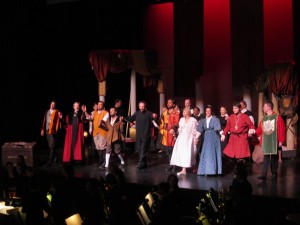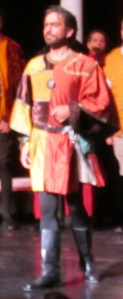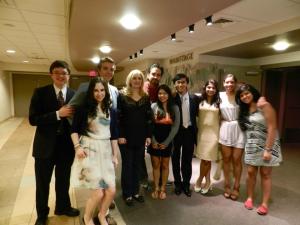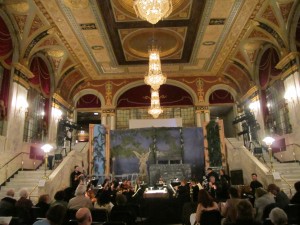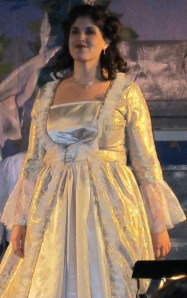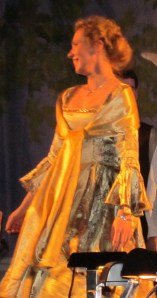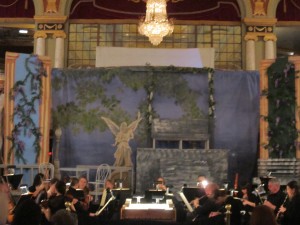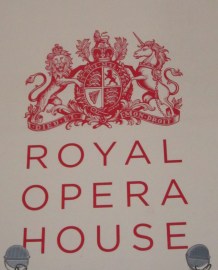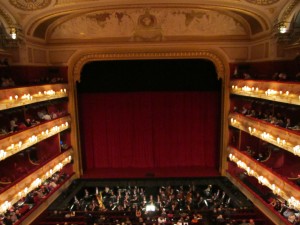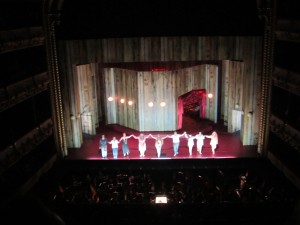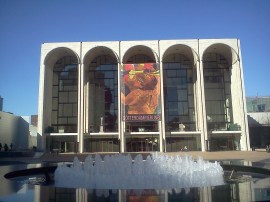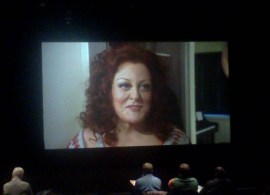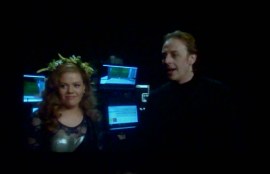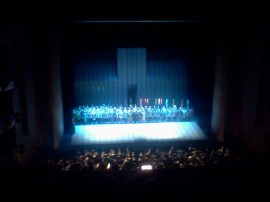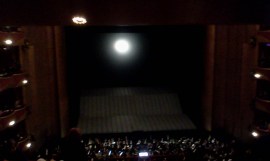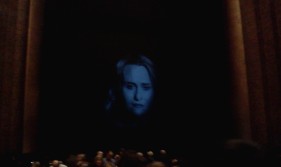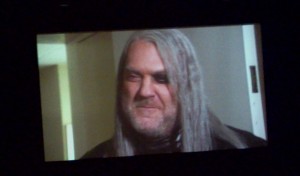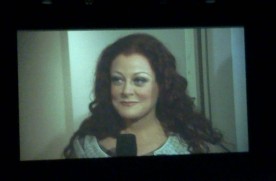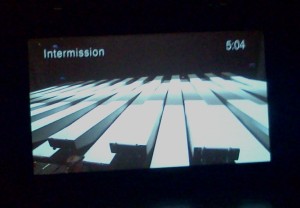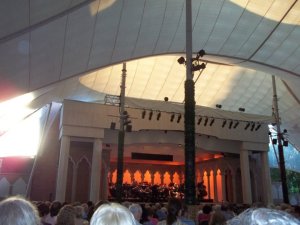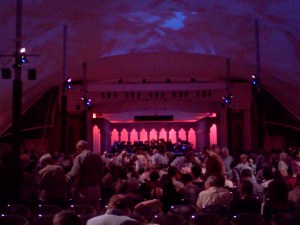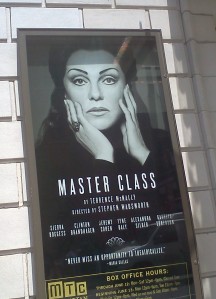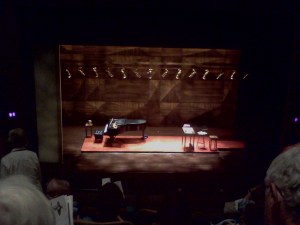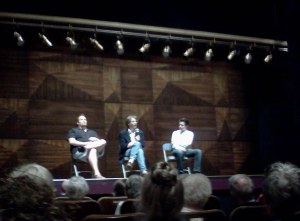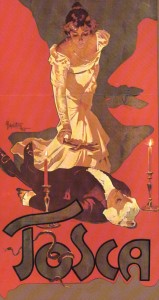I’ve Moved!
Now that I am attending Columbia University, I will no longer be posting to The Bent Nail Teen Opera Blog. It has been a wonderful two years writing here, and I thank all my readers for their support.
But there is a bright side!
I now write opera reviews for the Columbia Daily Spectator, the university newspaper. On my new blog, The Opera Spectator, I will post all my opera-related pieces that are published in the Spectator as well as some exclusive blog-only content!
On The Opera Spectator you’ll find the same “fresh perspective” that you love on The Bent Nail, simply in a new location.
Hope to see you there!
CLO Tackles A Verdi Masterwork
Every season, Connecticut Lyric Opera (CLO) offers increasingly ambitious presentations of operatic masterpieces in scaled-down settings. Because the company can only draw from a small pool of resources – chamber-sized orchestra, limited scenic budgets, and a small chorus – it is well suited to perform the more intimate operas in the standard repertory (a recent example was a splendid presentation of Mozart’s Così fan Tutte this past March). However, the company also successfully mounts much grander operas as well. These presentations require more work from the ensemble and push the company to its limits, but CLO seems to have an insatiable desire for these challenges! Although they often succeed with these larger operas, I was still skeptical whether the team could faithfully present Verdi’s expansive Otello (based on Shakespeare’s drama Othello) in the Spring of 2012.
The opera is a challenge for an opera company of any size, let alone CLO. The three principal roles – the general Otello, his youthful wife Desdemona, and the sinister Jago – each have extremely challenging music to sing throughout the work, which pushes the singers to manage intense outbursts of belted high notes amidst moments of delicate beauty. Any tenor performing the title character assumes a role which tests his entire range, including much sustained high singing. The opera also features an orchestration that is bold and brassy, a bevy of powerful choral singing, a host of smaller roles that must be well executed, and a dramatic storyline which can prove difficult to interpret credibly. With the piece requiring any opera company to realize all of these qualities, it seemed impossible that CLO could capably perform it; however, once seated in Waterbury’s Naugatuck Valley Community College Fine Arts Center on May 19th, I was captivated by CLO’s superb performance!
An audio excerpt of John Tsotsoros as Otello:
John Tsotsoros brought a bright tone and clear precision to the title role of the jealous Moor. Mr. Tsotsoros does not come to the part with a hefty instrument, but instead sings with lyric, Italianate timbre. He easily tackled the role’s many high notes without forcing, and produced focused and penetrating top notes that sliced through the textured orchestration. Although his characterization of the role tended towards the overly demonstrative, he was still able to move the audience with moments of touching sentimentality.
As the devilish Jago who perpetuates Otello’s descent into irrational rage, baritone Matthew Gamble delivered a truly standout performance. Since May of 2010, Mr. Gamble has sung in four productions with CLO in operas by Puccini, Mozart, and Offenbach. In most cases, Mr. Gamble has been cast in supporting roles, for he is still a young performer, but with the role of Jago, Mr. Gamble was finally able to showcase the full range of his developing talent. Despite slightly muddled diction, the baritone delivered a riveting performance with his smooth and pure voice. With clarity and ease in his voice from top to bottom, Mr. Gamble sang without any indication of strain and produced his most vocally skilled performance I’ve heard. High notes were solid, and the conviction to his sinister character was ever enjoyable to witness.
Rounding out the trio of principal singers, CLO veteran soprano Jurate Svedaite as Desdemona delivered another finely crafted portrayal of a classic operatic heroine. As is the standard for Ms. Svedaite performances, her singing was the essence of lyrical beauty. With polished phrasing, clear and luminous top notes, and understated but compelling acting, Ms. Svedaite captivated the audience whenever onstage. Her Fourth Act “Willow Song” and “Ave Maria” were breathtaking both in the gorgeous quality of her singing and the poignancy of her acting.
An audio selection featuring Mr. Tsotsoros and Ms. Svedaite from the end of Act One:
CLO also did a fantastic job assembling a strong cast of talented singers to contribute in the supporting roles. I was pleasantly surprised within moments of the curtain’s rising with the singing of young tenor Chris Lucier as Roderigo. With bright and precise singing, Mr. Lucier made quite an impression in this small role. In the drinking song with Jago, Mr. Lucier produced vibrant top notes. Here is certainly a talent I look forward to seeing grow artistically and perform principal roles.
As Jago’s wife Emilia, mezzo-soprano Brooke Larimer worked well with her soprano counterpart Ms. Svedaite and contributed nicely in ensembles. The tenor Daniel Juarez as Cassio once again sang with a gravelly sound that seemed a bit too husky for the role. Baritones Ryan Foley as Montano and Steve Fredericks as Lodovico contributed nicely with strong, well-sung performances, and in his brief appearance, Hartley Horn was a suitable herald.
Unfortunately, even with cuts made, Verdi’s thundering score proved overwhelming for the small CLO chorus. Made up of a dozen or so choristers (only two or three of whom were men), the dedicated ensemble was barely audible over the brilliant wall of sound coming from the orchestra pit.
In contrast to the underwhelming efforts of the chorus, the intimate Connecticut Virtuosi Chamber Orchestra under the baton of Music Director Adrian Sylveen surpassed expectations and captured all of the fireworks in Verdi’s music. As always, this orchestra breathed life and energy into every moment of this opera, and helped the audience the many nuances and details of the masterful orchestration.
An audio excerpt from Act Three of CLO’s presentation of Verdi’s Otello:
Another audio excerpt of Mr. Tsotsoros is the title role can be found here.
Again, CLO was able to conjure theatrical magic even within a limited budget. The production by stage director David Jaffe included a single set for all four acts. The scenery was a simple arrangement of pillars and platforms, but with some decorative accents (small foliage, a coat of arms, etc.), it served as a visually engaging arena within which the drama could easily unfold.
This performance proved once again that CLO can capably present almost any opera in the standard repertory with its uniquely intimate and inventive performances. The company draws upon a wealth of fabulous talent, and all of their artists, no matter what role they play, bring passion and dedication to every moment onstage, in the pit, or behind the scenes. This is a company that deserves to be seen by every variety of opera fan, but unfortunately, this performance, like many others I’ve enjoyed, was poorly attended. CLO is a gem of the Connecticut cultural community, and I urge everyone to please give them a try. You certainly will not be disappointed! More information about this fantastic company can be found at their website.
To contact me, please send me an email at bentnailopera@gmail.com
An Absolutely Charming “Così”
Because of their commitment to presenting core repertory operas in clever and inventive productions with talented casts, Connecticut Lyric Opera (CLO) has become a favorite of mine. The company’s recent performance of Mozart’s witty Così fan Tutte on March 17th at the Palace Theatre in Waterbury, CT continued CLO’s legacy of quality opera productions. Despite a disappointing turnout of only one hundred – a size that forced the Palace to move the performance to their lobby – the company delivered one of their best performances I’ve seen. With a talented young cast and the exceptional Connecticut Virtuosi Chamber Orchestra, the performance was a wonderful presentation of chamber opera. While it was unfortunate that our local community could not fill the ample Palace auditorium (most likely a result of the city’s cultural disregard and not the CLO product), it was also a treat to experience this intimate opera in a smaller venue. With lavish decorations, marble floors and close proximity to the performers, this space seemed like a theater of the Imperial court used at the time of the opera’s 1790 premiere.
The story – centering on a humorous account of young love gone awry– was performed by a fittingly young cast. Overwhelmingly, the three female principals stole the show. As the sisters Fiordiligi and Dorabella, soprano Dana Schnitzer and mezzo-soprano Aleksandra Kaminska were youthful, attractive and believable performers. Ms. Schnitzer’s voice is quite large and absolutely soared in the small hall. Although she struggled with some of the role’s long legato lines, she excelled throughout the performance and delivered many clear and accurate top notes. Ms. Schnitzer has a talent which is well suited for the world’s larger opera companies and has a voice which will thrive in bigger auditoriums.
As her sister, Ms. Kaminska brought a light mezzo and delicate phrasing to the role. Ms. Kaminska contributed nicely to ensembles, but also excelled in her solo arias. With her natural beauty and intelligent acting, she capably portrayed the character’s fickle attitudes and unsure emotional states.
As the slightly scheming maid Despina, Connecticut native Aleksandra Romano was humorous and enjoyable. With expressive faces and gestures, Ms. Romano captured the essence of the wily character, and she sang the role with bright and charming singing.
Another standout performance of the evening was delivered by bass-baritone Luke Scott who has commanded the CLO stage with wonderful performances in the past (reviewed on this site for his performances in Puccini’s Gianni Schicchi and Tosca). With a forceful yet velvety tone, Mr. Scott consistently lends skillfully sung and capably acted portrayals to all his characters. In addition, Mr. Scott was perfect singing opposite both Ms. Schnitzer and Ms. Kaminska. This performance was no exception to Mr. Scott’s consistent delivery of quality portrayals, as he gave the most developed and fully realized performance of the male leads.
As Dorabella’s lover Ferrando, Daniel Juarez seemed out of place with the rest of the young cast. Mr. Juarez’s gravelly tenor lacked much of the lightness needed to deliver the high-lying role. Despite these shortcomings, Mr. Juarez committed admirably to creating a realistic character and sang a truly affecting “Un aura amorosa” in Act 1.
Rounding out the vocal sextet, Seattle native Miles Rind was a more than satisfactory Don Alfonso. Despite some instances of poor diction, Mr. Rind still delivered a well sung and strongly acted performance of the cynical older gentleman.
During their occasional onstage appearances, the CLO Chorus complemented the principals with sweetly sung passages. More impressive, the small ensemble exhibited a pure joy for singing with their cheery onstage demeanor and happy facial expressions.
The Connecticut Virtuosi Chamber Orchestra under the direction of Music Director Adrian Sylveen imbued Mozart’s score with an intimate chamber quality. Because of the orchestra’s small size and proximity to the audience, one could clearly recognize the finer details of the well-crafted music. As always, with technical skill and melodic beauty, these talented musicians helped the audience appreciate the range of orchestral colors in this well-known score.
Aesthetically, this production directed by Eva Summer with sets and costumes by Katie Jurkiewicz was the best I’ve seen from CLO! With each new show, CLO consistently raises their production quality, and here, the single set with elegantly painted backdrop, floral accents, and cool blue-grey color scheme, was a pleasing representation of the opera’s seaside setting. The costumes were bright and colorful and complemented such refreshing scenery. I am eager to see how CLO interprets Verdi’s Shakespeare epic Otello this May.
Despite this quality performance by CLO, very few people filled the theater. As mentioned earlier, because of the weak attendance,the opera was presented in the theater’s lobby. This is a shame, for such a professional company deserves more support from a loyal community. Please take the initiative, if you can, to research and support this quality opera company in Connecticut. Even more so, I urge everyone to patronize performing arts organizations in your own backyard. Without us, these companies – which contribute vital cultural nourishment to our small communities – will cease to flourish.
For a video of excerpts from this production, click here, and for more information on Connecticut Lyric Opera, please see their website.
The Bent Nail Goes Abroad…The Sequel
Similar to Spring Break last year, I traveled with a school trip to Europe. Also similar to last year, I took this opportunity to enjoy a performance at one of the world’s leading opera houses. This year’s trip was to the United Kingdom, and my operatic pursuits lead me to London’s Royal Opera House, Covent Garden to see a March 9th performance of Dvorak’s Rusalka. Despite some lingering jet lag and a seat with no armrests, I was able to enjoy a fine evening full of excellent music in this wonderful opera house.
Almost instantly, I fell in love with the Royal Opera House. Full of rich wood-paneled walls, warm red velvet seats, and bright gold and ivory decorations, the house was welcoming and was complemented by friendly staff members. Many of the walls, lined with photographs of singers of the past, resembled a giant scrapbook of Royal Opera legacy. Overall the house was inviting and intruging to this Yankee.
Once perched in the Amphitheatre section at the top of the auditorium, the views of the stage were marvelous and the sound was incredible. At that level, the acoustics were phenomenal, and the singers’ clear and powerful voices soared over the vibrant orchestra. In total, the Royal Opera House seemed an excellent place to experience the masterpieces of the operatic canon.
My video from inside the Royal Opera House:
It was easy to enjoy my evening at the Royal Opera, for Dvorak’s beautiful yet challenging music was so masterfully delivered. The title role of the water nymph longing to be human was sung by Finnish soprano Camilla Nylund who excelled in interpreting this demanding part. With a scope of almost Wagnerian extremes, the role of Rusalka includes many moments of lyrical beauty but also features outbursts of focused high notes. With her steely Slavic sound, Ms. Nylund skillfully captured much of the nuance in this taxing part.
Portraying Rusalka’s sometime lover, the fickle prince, a tenor must also rise to near-Wagnerian heights. The role is laced with moments of sustained high singing requiring power but also clarity. Bryan Hymel was astonishing as he made all this difficult music seem easy. Mr. Hymel delivered the repeated top notes without any indications of strain. Furthermore, his performance was consistent throughout, and the tenor never appeared fatigued. This was truly a standout appearance by a talented young singer.
As Rusalka’s father Vodník, bass-baritone Alan Held commanded a strong presence with intense and direct singing. Mr. Held also mastered the character’s poignant moments dealing with his wounded daughter, making intelligent use of lyrical singing. As the witch Ježibaba, mezzo soprano Agnes Zwierko brought forceful and penetrating singing to the cutting role.
German-born Petra Lang also made a powerful impression as the sinister foreign princess. Although onstage for only a single act, Ms. Lang delivered a searing performance with intense and riveting singing. As the gamekeeper and kitchen boy, Gyula Orendt and Ilse Eerens were a humorous and complimentary duo. Anna Devin, Madeleine Pierard and Justina Gringyte as the wood nymphs sang with pleasant voices and sounded especially lovely when blending in trios.
Under the baton of spitfire young conductor Yannick Nézet-Séguen, the Royal Opera orchestra delivered an energetic rendition of Dvorak’s textured score – characteristic of the ebullient maestro. In fact, the orchestra received the audience’s most overwhelming and appreciative ovation of the evening.
So far, my evening at the Royal Opera may seem perfect, and for the most part it was. The only drawback was the absurd production by directors Jossi Wieler and Sergio Morabito and set designer Barbara Ehnes. A confusing mix of hunting lodge décor in a strip-club-like interior, the set included wood-paneled walls, what appeared to be a cabaret stage, a neon-lit cross, and a tacky porcelain bird bath/fountain. The wood nymphs were adorned with panties and sheer negligees leaving nothing to the imagination, while Ježibaba appeared as a decrepit old woman with an over-emphasized limp and walker. In one instance, to depict Rusalka’s transformation from water sprite to human being, a dancer in a cartoon-like cat suit showered Ms. Nylund with a torrent of prescription drug capsules. With touches like these, the production seemed a confused attempt to derive an obtuse meaning from Dvorak’s tragic fairy tale.

The Cast from Left to Right: Gyula Orendt, Ilse Eerens, Petra Lang, Agnes Zwierko, Camilla Nylund, Yannick Nézet-Séguen, Bryan Hymel, Anna Devin, Madeleine Pierard, and Justina Gringyte (Alan Held was Absent from Curtain Calls)
Some images from the Royal Opera’s production of Dvorak’s Rusalka:
Despite this flaw, my time spent in this glorious theater listening to a remarkably wonderful musical performance made the experience unforgettable! For more information on my trip, please feel free to email me at cbrowner@traftschool.org
Ring Cycle for the 21st Century – “Götterdämmerung”
For the past two seasons, a main feature of conversation surrounding New York’s Metropolitan Opera House is the company’s presentation of a new staging of Richard Wagner’s momentous, four-part cycle Der Ring des Nibelungen. The project led by Canadian director Robert LePage has attracted both harsh criticism and praise for its approach to the work through the use of advanced stage technology and interactive projections. With the January 27th premiere of the cycle’s final opera, Götterdämmerung, the Met has a new Ring for the first time in over two decades (Bent Nail reviews of the previous installments of the LePage Ring Cycle can be found here: Das Rheingold, Die Walküre, Siegfried.) I saw two performances of this opera: live in the house on February 3rd (with an alternate cast) and then “Live in HD” at a local movie theater on February 11th. Although much of the production and portrayals were well crafted and artfully delivered, on some occasions the performances fell below expectations.
Both Brünnhildes – Katarina Dalayman (Feb. 3rd) and Deborah Voigt (Feb. 11th) delivered well-sung and powerfully-acted interpretations of the warrior-goddess turned human-heroine. Ms. Dalayman’s large vocal presence was a natural fit for the daunting role. With nuance and clear top notes, she gave a strong performance, though she seemed to tire in the opera’s final crucial moments. Ms. Voigt’s singing of the role was a surprisingly confident and lyrical rendition. After her labored performances in Siegfriedonly three months earlier, I was afraid Ms. Voigt’s voice lacked the clarity and stamina for the role. However, her portrayal of Brünnhilde was strong both in precise high notes and lyrical singing which captured the character’s range of emotions. Both sopranos displayed a natural prowess for acting, and both successfully captured the character’s turbulent journey throughout the almost six-hour-long opera.
The role of Siegfried was also split between two talented performers, Americans Stephen Gould (Feb. 3rd) and Jay Hunter Morris (Feb. 11th). Each man came to the role from a different perspective – resulting in two quite different portrayals of the heroic figure. Mr. Gould sang the role very much as a traditional heldentenor. With a hefty sound accompanied by an oversized frame, Mr. Gould delivered a commanding performance with punched high notes. In contrast, Mr. Morris sang with a lighter, more lyrical tone and delivered the many sections of high tessitura with ease. Both of these men’s performances were strong and allowed me to enjoy different approaches to singing the vocally taxing role.
Where these two performers contrasted was in their acted portrayals. Mr. Morris’s enthusiasm for his character was evident as he masterfully gave believable dimensions to the role. Mr. Gould seemed less experienced with the staging, and his lack of rehearsal attention (he was not a member of the principal cast) was evident as he lumbered about the stage more than creating a finely crafted character. Both these men gave hope that proficient singers are rising to tackle this terribly difficult music.
More powerful performances were delivered by members of the supporting cast. The talented Hans-Peter König delivered a superb display as the half-human, half-nibelung Hagen. With a sonorous, powerful, and pure bass, his portrayal was thrilling. As his half siblings King Gunther and Princess Gutrune, Iain Paterson and Wendy Bryn Harmer respectively delivered strong performances as the pivotal characters. Mr. Paterson, with smooth baritone even in forceful passages, portrayed the spineless king with conviction. Ms. Bryn Harmer was a conniving Gutrune who, with her physical beauty and lyric soprano, successfully seduced the innocent Siegfried. In her one appearance as the valkyrie Waltraute, Waltraud Meier made a captivating impact with a powerful rendition of her Act One narrative.
In his cameo appearance as the Nibelung Alberich, Bass Eric Owens gave life to the creepy character as he writhed and contorted across the stage and sang with his characteristic hefty bass. As the two sets of three women, Maria Radner, Elizabeth Bishop, and Heidi Melton as the Norns and Erin Morely, Jennifer Johnson Cano, and Tamara Mumford as the Rhinemaidens contributed nicely to the overall dramatic experience with well-sung performances.
Another set of star singers was the Metropolitan Opera Chorus (especially the men’s chorus) in their only appearance in the whole of the Ring. As soon as they hit the stage, the men’s chorus constructed a wall of sound with their well-crafted singing. Conquering the difficult choral music with seeming ease, the chorus blew the audience away whenever onstage. The Metropolitan Opera orchestra under Fabio Luisi played the score with proficiency, though on occasion Maestro Luisi did not seem to wring all the fullness he could out of Wagner’s lush score.
Many aspects of the production were quite effective at both weaving a tale of myth and fantasy and capably representing Wagner’s ambitious stage directions. Just as in the earlier production of Siegfried, the “machine”which is the central element of the staging moved often to evoke a vast range of locations for scenes to inhabit. This technique gave the drama a wider-ranging sweep for the plot to unfold than traditional production techniques allow. Furthermore, the production’s use of digital projections (waterfalls, flames, foliage, etc.) created evocative settings, and the director’s choice to stage Siegfried’s Rhine Journey with a rocking raft and horse puppet was a clever approach.
And while many of the production choices came close to realizing Wagner’s vast vision, on several occasions they were cheesy and ineffectual. One notable disappointment was the final five minutes of the opera – “Brünnhilde’s Immolation Scene”. The libretto calls for a giant funeral pyre growing to consume a great hall, the Rhine overflowing its banks, and the destruction of the gods and their home Valhalla. This is obviously impossible to stage fully in a theater, but even this production’s attempt to depict the action left too much to the imagination. In fact, the way in which the production did attempt to communicate the story –Brünnhilde’s horse puppet being pushed towards a funeral pyre, a wall of fire projection, and statues of the gods exploding and falling apart – was inappropriately humorous. One woman commented “You’re not supposed to be laughing at the end of the ‘Immolation Scene’”. After clever and vivid imagery throughout the cycle – and especially in the final two installments – I couldn’t help but feel disappointed at the close of the performance.
Some Video Excerpts From Götterdämmerung:
Despite a few tacky elements, overall this production is quite a spectacle which uses traditional dramatic elements and modern technology to evoke the mythical fantasy of Wagner’s imagination. Complete cycles of the LePage Ring begin on April 7th and run through May 12th. For more information, visit the Met’s website or see the Met’s new Ring website. And for tons of great photos of this production, click here.
“Faust” Falls Flat
New productions at the Metropolitan Opera always garner much attention, and many provoke controversy amongst opera lovers everywhere. The Met’s new production of Gounod’s Faust was no exception, and because of the choice to update this medieval tale to the 20th century, much speculation surrounded its premiere. The stellar line-up of principal singers under the guidance of a youthful and energetic conductor and a production by an award-winning theater director seemed to position this Faust as a promising addition to the Met’s repertoire. However, after attending the December 20th performance, I came away disappointed by inconsistencies found throughout the evening.
Coming off a heroic run as Siegmund in the Met’s presentations of Wagner’s Die Walküre last season, German tenor Jonas Kaufmann took on the title character of the aging-scholar-turned-youthful-cad. The role requires an abundance of smooth, lyrical singing and light French tone – qualities absent from Mr. Kaufmann’s performance. His voice is a beautiful instrument, but his hefty, dark sound seemed inappropriate for the music of the title role. Furthermore, Mr. Kaufmann’s performance on this particular evening was marred by inconsistencies. He delivered many moments of velvety phrasing that caused the whole audience to melt, but on other occasions he gracelessly attacked lines and high notes. Because of the almost baritonal quality of his singing, any contrast between Mr. Kaufmann’s sound and the other male vocal lines was lost. I have much respect for Mr. Kaufmann and believe him a great interpreter of the heavier roles in the tenor repertoire, but I feel that the role of Faust is not a natural fit for this talented performer.
Below is an excerpt of Jonas Kaufmann’s performance of “Salut! Demeure chaste et pure”:
As the object of Mr. Kaufmann’s seduction, soprano Marina Poplavskaya – who divided Met audiences last season with performances in Verdi’s towering Don Carlo and classic La Traviata – delivered a committed portrayal of the innocent Marguerite. “Impulsive” is a word that best captures the essence of Ms. Poplavskaya’s craft, for she completely adopts a new persona onstage. All of Ms. Poplavskaya’s actions seemed natural as she totally embodied her character, and her voice was well suited for the role’s varied music. Unfortunately, her no-holds-bar style took a heavy toll on her singing in the latter parts of the opera. Here Ms. Poplavskaya forced her singing – a few times going slightly flat on top notes. I will continue to enjoy Ms. Poplavskaya’s appearances, for she consistently delivers compelling portrayals, even if she sometimes sacrifices vocal beauty in the process.
Mariana Poplavskaya as Marguerite sings the “Jewel Song” from Gounod’s Faust:
The most polished and balanced performance of the evening came from veteran bass René Pape as Méphistophélès. His pure, rich sound allowed him to comfortably deliver the role’s diverse and challenging music. Mr. Pape’s suave and charming Méphistophélès swaggered around the stage with ease and confidence, though at times, especially during larger crowd scenes, Mr. Pape’s acting bordered on camp. However, the blame for this likely falls upon the director rather than this accomplished artist.
A portion of the first act duet between Faust (Jonas Kaufmann) and Méphistophélès (René Pape):
As Marguerite’s noble brother Valentin, baritone Russell Braun sang with gorgeous tone throughout the evening and contributed a beautiful “Avant de quitter ces lieux” in the second act. As Siebel, mezzo-soprano Michèle Losier sang with nice, lyric tone and easily portrayed the character’s youthful demeanor. Both Theodora Hanslowe as Marguerite’s nosey neighbor Marthe (replacing Wendy White, who was injured in a prior performance) and Jonathan Boyer as Wagner both contributed to the performance with strong appearances.
The orchestra and chorus under the direction of Maestro Yannick Nézet-Séguin –a French-Canadian conductor in his mid-thirties – exhibited their trademark proficiencies. Maestro Nézet-Séguin imbues a natural energy into every performance, and this quality is manifest in the explosive playing he evokes from his musicians. This quality breathes life into each performance, but on this occasion Maestro Nézet-Séguin tended to cover the singers in the early moments of the opera and took some time to relax into a comfortable relationship between the pit and the stage.
An excerpt from the third act love duet:
The truly noteworthy aspect of this evening’s performance was the production by Tony award-winning director Des McAnuff. The production was framed as a flashback in the mind of the title character as he commits suicide by poison. Mr. McAnuff places the story between the beginning of the First World War and the detonation of the atomic bomb nearly thirty years later, and the aging Faust is characterized as a scientist working on the nuclear Manhattan Project – in fact the whole production takes place in a laboratory. On the surface, the concept seemed a fresh re-imagining of the classic tale, but the execution proved insufficient at realizing this well-intentioned goal. Overall, it seemed that the production team tried too hard to be clever, resulting in a stage often cluttered to the point of distraction. Burn victims carrying bomb components,villagers convulsing rhythmically, jarring camera flashes, and random bursts of white and green light – These are but a few of the many production techniques which undermined the unique concept. With alterations and editing, this production has the potential to be an ingenious take on the classic opera, but in its current state, this approach does not ably showcase the merits of Gounod’s opera.
Faust continues its run at the Met through January 19, though some of the singers mentioned in this post are no longer with the production (most notably Mr. Kaufmann and Mr. Pape), and encore presentation of the December 10th “Live in HD” broadcast can be seen on January 11th in the United States and on February 4th and 27th in Canada.
For a full photo gallery of this production of Faust click here, and please check out director Des McAnuff discussing his production.
If you have questions or comments about this performance of Gounod’s Faust please feel free email me at cbrowner@taftschool.org
Ring Cycle for the 21st Century – “Siegfried”
A waterfall flowing into a placid pool, leaves cascading onto a mountain clearing, birds swooping in and gliding over water – these are but a few of the images employed in the Met’s new, technologically innovative production of Siegfried. Here is a video which represents this use of technology:
I wanted to attend all four of Robert LePage’s ambitious productions of Wagner’s monumental work Der Ring des Nibelungen live in the opera house, but my schedule prevented me from seeing any performances of the third opera, Siegfried, at the Met (visit these links for my take on the first two operas: Das Rheingold and Die Walküre). Instead, I attended the “Live in HD” presentation on November 5* at the Warner Theatre in Torrington, Connecticut. As with the second opera in the cycle, Die Walküre, this installment improved upon its predecessors and was in many ways the best so far.
In an operatic turn of events, the veteran heldentenor Gary Lehman was forced to withdraw because of illness and was hastily replaced by Jay Hunter Morris, a youthful tenor from Paris, Texas. The role of Siegfried is acknowledged as one of the most difficult in the standard repertoire, and while Mr. Morris still has some growing to do in this part, his performance was balanced vocally and dramatically. His lyric tone was effective in this demanding role, and throughout the afternoon, Mr. Morris was very convincing as the rambunctious teenager. His performance could well be a milestone in the career of a promising young tenor.
Veteran tenor Gerhard Siegel displayed proficiency in the role of Mime, a part which he has sung dozens of times. His experience with the character was evident, as he delivered a unique and nuanced performance without compromising the integrity of Wagner’s music.
As the Wanderer (the god Wotan in disguise), Welsh bass-baritone Bryn Terfel continued his tradition of delivering dramatic and compelling performances on the Met stage. While bearing a striking resemblance to Lucius Malfoy, Mr. Terfel delivered a commanding performance with his pure, lyrical sound. Unfortunately, in some of the most dramatic moments of the opera, he sacrificed beauty for intensity, and tended toward shouting. Nonetheless, I have enjoyed watching Mr. Terfel develop a multi-faceted characterization of this role throughout the cycle.
In her first experience as Brünnhilde, soprano Deborah Voigt continued to come up just short of greatness. To my ears, Ms. Voigt does not possess the clearest tone, and in this performance she seemed to stretch her voice to reach the top notes. She just barely touched her final high-C before cutting it off abruptly. However, what Ms. Voigt lacks in vocal beauty, she compensates for with committed and realistic characterizations. In her relatively short stage appearance, Ms. Voigt skillfully portrayed Brünnhilde’s wide range of emotions– from utter shock to deep despair and, finally, sensual bliss – and created wonderful chemistry with Mr.Morris. I await Ms. Voigt’s appearance in Götterdämmerung with some trepidation – then again, I’ve been pleasantly surprised by her performances in the past.
In his brief appearance as the scheming dwarf Alberich, bass-baritone Eric Owens sang with his characteristic sonority, which at times seemed too pleasant for such a diabolical character. Hans-Peter König, as the giant-turned-dragon Fafner, sang with a powerful, full-bodied bass, and mezzo-soprano Patricia Bardon exuded mystery as the Earth goddess Erda with dark tone and mystical stage presence complemented by her otherworldly costume. Soprano Mojca Erdmann contributed nicely to the second act with a lovely offstage performance of the forest bird – represented onstage by an ingenious video projection.
The Metropolitan Opera orchestra is generally regarded as one of the world’s best, but under the baton of newly-appointed Met Principal Conductor Fabio Luisi, their playing was even more exquisite. They evoked a remarkable range of orchestral color – from aching beauty to grand lyricism to harsh anxiety.
As noted earlier, this installment of the Robert LePage Ring cycle presented a winning combination of innovative technology and traditional dramatization. The projections and images were constantly moving, breathing life into every scene. Using captivating, three-dimensional imagery, the production capably depicted the opera’s connection with the natural world. I am excited to see the final installment of the cycle later this season, for I am confident LePage’s team will continue to realize Wagner’s grand mythological vision with their unique interpretive skills.
I highly recommend that you explore this webpage for video excerpts and background information on the Robert LePage Ring Cycle. And the Met’s Ring Cycle minisite is also a must-see!
Wagner’s Siegfried will be presented later this season as part of the complete Ring Cycle. For more information, visit the Met’s website. And to see an extensive photo gallery of the production see this link.
A video of Jay Hunter Morris singing the Act 1 “Forging Song”:
*For those readers who haven’t heard of Met’s Live in High Definition program, the Met presents close to a dozen live broadcasts of Saturday matinée performances live into movie theaters in fifty-four nations worldwide. For more information on this series, click here.
With questions or comments, please email me at cbrowner@taftschool.org
Summer Opera Traditions
One of the most melancholy days for any opera fan falls in the middle of May when the curtain closes on the final performance at the end of a Metropolitan Opera season. This moment begins a period of four months of no live opera on the Met’s grand stage. For diehard New York opera fans, the summer months can feel endless as we await opening night of the new season in late September. However, every year one can find a variety of local opera events to keep the summer musical. For years I have attended the same events, and this year, these two happened to fall within two days of each other – a presentation of Rossini’s last and grandest opera Guillaume Tell on July 9th followed soon after by an opera recital in Manhattan’s Central Park on July 11th. This operatic long weekend was able to provide enough delightful music to keep me satisfied until the Met’s Summer “Live in HD” Festival in late August.
Since 1997, the Caramoor Center for Arts and Music (a peaceful and rural music complex surrounded by meadows and gardens in Upstate New York) – in addition to offering a summer full of symphonic and chamber music – presents two or three operas in concert as part of its “Bel Canto at Caramoor” series. This year, the company presented performances of Gilbert and Sullivan’s classic operetta H.M.S. Pinafore and Rossini’s rarely performed Guillaume Tell. To many this opera is Rossini’s masterpiece, and he composed it immediately before retiring from opera composition at the age of thirty-seven. In addition to being quite long – it runs over four hours without cuts – the piece has an intricate plot which proves difficult to stage. Yet even more challenging, Rossini demands much of every singer; giving them all technically complex and emotionally varied music. For these reasons, the work is rarely performed. It’s a shame that this piece is not presented more often, for it is undoubtedly one of the most beautiful, dynamic, and unified scores Rossini ever composed.
After hearing such a powerful performance this summer, I could understand why music experts praise this work so highly. Every aria, ensemble, choral piece, and orchestral interlude which make up the score are unique and novel while still being musically advanced. However, all these components work extremely well together and create one cohesive work.
Daniel Mobbs as the Swiss patriot William Tell carried the evening with his lyric bass-baritone, but his voice never seemed weakened by the lengthy role. The Austrian princess Mathilde was portrayed by soprano Juliana Di Giacomo dominated the stage with her gigantic voice. Although she overpowered her colleagues at times, Ms. Di Giacomo delivered a superb performance with soaring tones and dramatic intensity. And as the conflicted Arnold, Michael Spyres performed with a nice timbre and light top notes proving that he has the talent to be a great Rossini tenor. However, when contributing to larger ensembles, he struggled to hold his own.
In the “trouser role” of Tell’s son Jemmy, Talise Trevigne easily managed the high parts of the role with her sparkling soprano. As Jemmy’s mother Hedwige, Vanessa Cariddi performed with a hefty yet smooth mezzo-soprano. Ms. Cariddi was able to transition from the low-lying legato phrases to the occasional high notes with ease. As the sadistic Austrian governor Gessler, Scott Bearden delivered a powerful performance with his large baritone. Other notable performances came from tenor Brian Dowen delivering a finely sung fisherman and bass Nicholas Masters as Walter –William Tell’s fellow patriot. The Caramoor Festival Chorus contributed much to the performance with beautiful singing and its proficiency at handling the opera’s vast amount of choral music. The Orchestra of St. Luke’s under the direction of Maestro Will Crutchfiled played the opera’s textured score both expressively and dynamically.
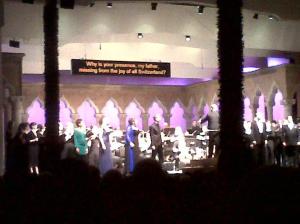
During the performance of "Guillaume Tell": from left Talise Trevigne (in green), Vanessa Cariddi, Julianna Di Giacomo, and Daniel Mobbs
The whole event surrounding the performance of this opera was thrilling. From an all-day series of stimulating lectures with Maestro Crutchfield and renowned musicologist Phillip Gosset to the final bows, the day was filled with excitement. There was a palpable feeling that all present where participating in a rare experience. As the famous finale from the Overture (better known to many as the “Long Ranger Theme Song”) flew out from the orchestra, a rush came over the audience, and this excitement carried through the rest of the evening. And once the final bars of music soared out over the audience, a roar of applause erupted like I’ve never heard at any other classical performance.
However, as electric as this performance was, the presentation of the opera in a concert setting does not do this work justice. Guillaume Tell is one of Rossini’s best operas and deserves to be staged more regularly in the world’s great houses. Much of the drama was lost in the concert staging, and some moments even seemed farcical (for instance the famous moment where Tell shoots an apple off his son’s head was presented without any attempt to convey the actions of the libretto – a choice which received chuckles from some audience members). Overall, this performance made a strong case for bringing Tell into the mainstream.
A video about Caramoor’s Young Artist Mentoring Program:
And for more information on the Caramoor Center for Arts and Music, click here.
To continue my operatic long weekend, I attended the first in a series of six Metropolitan Opera Recitals in parks throughout New York City. This recital took place in the center of Manhattan at Central Park Summer Stage. After a disappointing experience at Summer Stage last year, I was worried that many of the problems I encountered at that performance – a disrespectful staff, some poor choices in musical selections – would be repeated this time around. However, I was pleasantly surprised that every employee of Summer Stage was courteous, and the recital’s program included many popular pieces, as well as some lesser-known works that allowed the soloists to show off their talents.
Soprano Angela Meade – a winner of the 2007 National Grand Council Finals – began the recital on a “high note” with a nicely sung “Casta Diva” from Bellini’s Norma and displayed a natural talent for Bel Canto singing throughout the whole evening. With her pure tones, Ms. Meade excelled in many of her offerings and showcased a beautiful voice with delicately-sung, pianissimo high notes.
The second singer on the stage was Jennifer Johnson Cano, a member of the Met’s Lindeman Young Artist Development Program. With her light mezzo-soprano, Ms. Johnson Cano also excelled in the works of the Bel Canto composers Bellini and Donizetti. In duets with Ms. Meade, the two young singers complemented each other nicely, and a real thrill of the evening was “Sul suo capo aggravi un dio” from Donizetti’s Anna Bolena (the opera which is to open the Met’s 2011-2012 season and which will star Ms. Meade in subsequent performances) where they offered dramatic intensity and blended harmonies.
But of course this is opera – an art form teeming with drama – and it couldn’t be opera without some excitement. On this evening, the drama came in the form of a last-minute replacement of an ailing Dimitri Pittas for former Lindeman Young Artist Atalla Ayan (a Brazilian tenor making his Met debut with this recital). Mr. Ayan posses a mature-sounding voice despite being only twenty-five years old. With his powerful voice, he excelled in selections from a variety of standard repertoire (Gounod, Verdi, and Puccini) and produced vibrant and strong high notes. The audience at this recital may have witnessed the Met debut of a soon-to-be world-class tenor.
After two nights of pure operatic bliss I feel as if I can now endure the two more months until the beginning of the Met Season. I urge opera lovers to explore the musical events in their communities. And don’t feel too disheartened…the new season opens in fewer than two months!
You can learn more about these three young artists at these websites: Angela Meade, Jennifer Johnson Cano, Atalla Ayan.
Please leave a comment and feel free to email me at cbrowner@taftschool.org
Terrence McNally’s “Master Class” Revived on Broadway
A play about an operatic master class may sound like a lackluster experience to any theatergoer not completely infatuated with opera. What dramatic interest is there in a group of young singers being critiqued by an operatic veteran, even if it is famed diva Maria Callas? But Terrence McNally’s play Master Class goes far beyond depicting the goings-on in one of these sessions common in the world of opera. Instead, McNally uses the setting to communicate the story of one of opera’s most celebrated prima donnas. Although the play includes many memories from the diva’s professional and personal life, to consider it as only a biography would be to miss its true essence. Master Class reveals the struggles encountered in seeking success in one’s career and examines the sacrifices one must make in achieving these goals. When I heard that a revival of this play was being directed by Stephen Wadsworth on Broadway after a successful run at Washington’s Kennedy Center, I jumped at the chance to see it. The new production will play a limited engagement at Manhattan Theater Club’s Samuel J. Friedman Theatre during the summer of 2011. I attended an early preview performance on Saturday June 18.
Portraying the larger-than-life personality of the diva, Drama Desk, Tony, and six-time Emmy-award winning actress Tyne Daly embodied every aspect of the character. Ms. Daly did not simply act like Maria Callas – she was Maria Callas. Her every gesture, voice, and mannerism led the audience to believe Callas had been resurrected before them. Ms. Daly excelled in every component of the character. On countless occasions she was hilarious, though she never played her lines for laughs. Yet the highlights of her performance were two fifteen-minute-long monologues at the end of each act accompanied by live recordings of Callas performances. In these places, the audience sees deep into the life of Madame Callas as she gives voice to the memories and influential people from her past, most notably her former lover Aristotle Onassis. It almost seemed that these memories were Ms. Daly’s own. One could easily forget that she was acting.
In this fictional master class, the Callas character gives guidance to a tenor and two sopranos. The acting capabilities of these performers varied, yet all three delivered well-rounded performances. As the young soprano Sophie De Palma, Broadway debutante Alexandra Silber captured the naiveté and inexperience of her character. Although the play does not give the role many lines to sing, Ms. Silber’s pleasant voice was evident.
As the humorous “Tony the Tenor”, Metropolitan Opera comprimario Garrett Sorenson also is making his Broadway debut. Mr. Sorenson’s acting was a bit overstated for my taste, but many of his lines had the audience full of laughter. However, when singing the aria “Recondita armonia” from Puccini’s Tosca, Mr. Sorenson demonstrated that his true talent lies in his singing ability and potential as an operatic leading man.
Sierra Boggess, returning to Broadway after starring in The Little Mermaid, delivered the most complete performance of the three as the soprano Sharon Graham. Ms. Boggess’s acting was quite convincing, and the intensity of her showdown with Callas in the final moments of the play left me stunned. Despite the character’s early self-doubt, she is able to find the courage to resist Callas’s overpowering influence. Ms. Boggess was able to express a wide range of emotions and portray the character’s growth over the course of her time onstage. Ms. Boggess also poses a beautiful operatic voice. She delivered a powerful rendition of Lady Macbeth’s letter scene from Verdi’s Macbeth.
Jeremy Cohen as the accompanist Manny delivered a well-acted performance as the addressee of Callas’s beliefs about singing and the world of opera. In addition, Mr. Cohen exhibited his proficiency as a pianist when accompanying all three singers. Clinton Brandhagen as the stagehand completed the ensemble with a few notably humorous appearances.
The production by director Stephen Wadsworth was furnished with Thomas Lynch’s understated sets, which provided a perfect complement to the onstage action. Mr. Wadsworth, with numerous theater credits under his belt, also has directed in some premier opera houses, and clearly understands the world of opera. His direction was never heavy handed, and all the acting seemed natural. One especially effective touch came during Callas’s two monologues. The master class set would glide off the stage, and images of an opera house would appear. This focused all the attention on Ms. Daly and provided her with the freedom to work her theatrical magic.
This play is a must-see for any opera connoisseur, but I especially recommend it for young singers aspiring to a career in opera. Over the course of the two hours, the Callas character reveals her opinions, not only about singing, but also about how to be a singer. She explains that a singer must not only sing the notes, but embody the character, understand every word and action indicated in the libretto, and fully commit him or herself to the role. Also, Callas’s commentary demonstrates how one must be dedicated to one’s art and success. Although the play implies that Maria Callas practiced her art too aggressively – one student shouts “I don’t want to be like you…I don’t want to lose my voice in ten years!” – it asserts that the life of an opera singer, or any dedicated artist, requires considerable determination and sacrifice.
Excerpts from this production of Master Class:
This play is a fascinating take on the life of Maria Callas and an intense view into the world of opera. It is not only a great play about opera; it is an enthralling piece of theater with a talented ensemble cast and a superb leading lady.
Terrence McNally’s Master Class officially opens on July 07 and runs through August 14. For more information, click here.
The cast and creative team discuss Master Class:
An interview with playwright Terrence McNally:
And for another video of McNally discussing his play click here.
And here is opera writer Fred Plotkin’s take on the lead role in Master Class.
As always, please comment below or e-mail me at cbrowner@taftschool.org
The Bent Nail in the News
As publicity for Connecticut Lyric Opera’s presentation of Giacomo Puccini’s Tosca (discussed below), my local newspaper, The Waterbury Republican American, ran an article about me in the Arts section. For a copy of the story click here.

